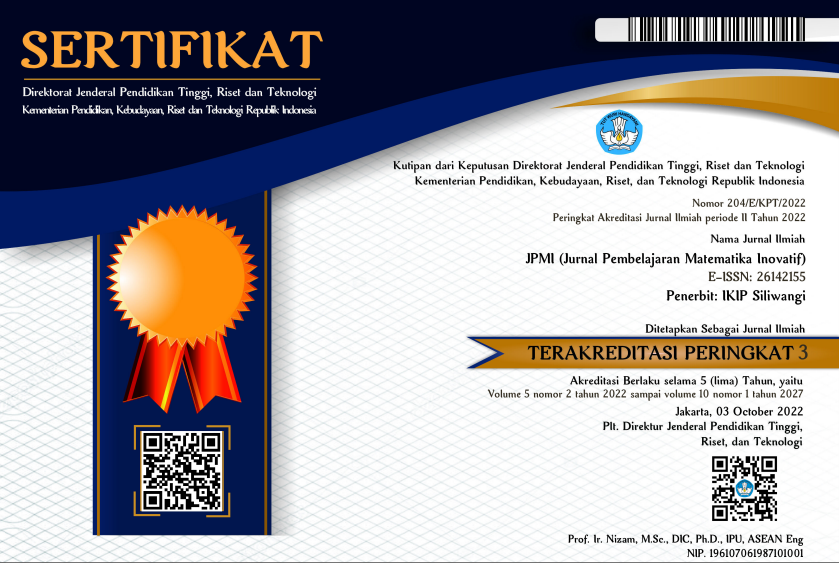Meningkatkan kemampuan pemecahan masalah matematis dengan model cooperative learning tipe student teams achievement division (STAD) pada siswa SMP
DOI:
https://doi.org/10.22460/jpmi.v7i3.23970Keywords:
Mathematical Problem Solving Ability, Cooperative Learning Model, Student Teams Achievement Division (STAD)Abstract
The ability to solve problems is an essential skill that students must have in everyday life and as an integral part of the math curriculum. The research aims to achieve and improve the mathematical problem-solving ability of junior high school students through the application of the STAD (Student Teams Achievement Divisions) cooperative learning model. The method used is a quasi-experimental design experiment. The results of the study found that before the implementation of the STAD model, students' mathematical problem-solving skills were still low, as seen from the results of the pre-test. This study concluded that cooperative learning STAD is effective in achieving and improving the mathematical problem-solving ability of junior high school students.
References
Asfar, A. I. T., & Nur, S. (2018). Model pembelajaran problem posing & solving. Sukabumi : CV. Jejak.
Dara, E. T., & Siregar, N. (2024). Penerapan model pembelajaran kooperatif tipe student teams achievement division berbantuan geogebra untuk meningkatkan kemampuan pemecahan masalah siswa kelas VIII. Jurnal Review Pendidikan dan Pengajaran, 7(1), 1224–1231. https://doi.org/https://doi.org/10.31004/jrpp.v7i1.25077
Firdaus, Z., Umi Masytoh, E., Amalia, N., Gondoarum, W. R., & Amaliyah, F. (2023). Efektivitas penggunaan model pembelajaran student teams achievement division terhadap kemampuan pemecahan masalah matematis siswa. Jurnal Prosiding Mateandrau, 2(2), 1–13. https://doi.org/https://doi.org/10.55606/mateandrau.v2i21399
Fitrianna, A. Y., & Yuliani, A. (2021). Analisis kemampuan mahasiswa calon guru dalam menyelesaikan soal hots materi lingkaran. Jurnal Pendidikan Matematika RAFA, 7(2), 183–193. https://doi.org/https://doi.org/10.19109/jpmrafa.v7i2.7732
Gumanti, Maimunah, & Roza, Y. (2022). Kemampuan pemecahan masalah matematis siswa SMP Kecamatan Bantan. Prisma, 11(2), 310. https://doi.org/10.35194/jp.v11i2.2301
Hadi, S., & Novaliyosi. (2019). TIMSS Indonesia (trends in international mathematics and science study). Prosiding Seminar Nasional & Call For Papers, 562–569. https://jurnal.unsil.ac.id/index.php/sncp/article/viewFile/1096/754
Haratua, C. S., Parlina, Y., Karmila, M., & Akbar, B. M. (2024). Peningkatan kemampuan berpikir kritis pada pelajaran matematika siswa kelas VI SD citarik III melalui model pembelajaran kooperatif tipe jigsaw. Katalis Pendidikan : Jurnal Ilmu Pendidikan dan Matematika, 1(1), 12530. https://doi.org/https://doi.org/10.62383/katalis.v1i1.100
Hutajulu, M., Senjayawati, E., & Minarti, D. E. (2019). Analisis Kesalahan siswa SMK dalam menyelesaikan soal kecakapan matematis pada materi bangun ruang. Moshafara : Jurnal Pendidikan Matematika, 8(3), 365–376. https://doi.org/https://doi.org/10.31980/mosharafa.v8i3.573
Hutajulu, M., Wijaya, T. T., & Hidayat, W. (2019). The effect of mathematical disposition and learning motivation on problem solving : an analysis. Infinity : Journal of Mathematics Education, 8(2), 229–238. https://doi.org/http://orcid.org/0000-0002-4075-8110
Kusnafizal, T. (2020). Pengaruh model pembelajaran : tipe talking stick dengan strategi inquiry terhadap prestasi belajar siswa. Riwayat : Eduvation Journal of History and Humanities, 30(2). https://jurnal.usk.ac.id/riwayat/article/view/19665
Mawarni, J., Syahbana, A., & Septiati, E. (2019). Pengaruh strategi pembelajaran react terhadap kemampuan berpikir kritis ditinjau dari kemampuan awal siswa SMP. Indiktika : Jurnal Inovasi Pendidikan Matematika, 1(2), 172–180. https://doi.org/10.31851/indiktika.v1i2.3190
Mullis, I. V. S., Martin, M. O., Foy, P., & Hooper, M. (2016). Timss 2015 International results in mathematics. TIMSS & PIRLS International Study Center. http://timssandpirls.bc.edu/timss2015/international-results/
Ningsih, E. F., & Anggraeni, V. (2020). Meningkatkan kemampuan pemecahan masalah matematis melalui problem based learning. Abacus Primagraha, 1(1), 25–37. https://doi.org/10.59605/abacus.v1i1.383
OECD. (2023). PISA 2022 results (volume I) : the state of learning and equity in education. OECD iLibrary. https://doi.org/https://doi.org/10.1787/53f23881-en
Prayoga, M. F., Safitri, D., Fahmi, F., & Damanik, M. H. (2021). Model pembelajaran kooperatif tipe student teams achievement division untuk mengetahuin perbedaan kemampuan pemecahan masalah dan motivasi belajar siswa. MES: Journal of Mathematics Education and Science, 6(2), 1–8. https://doi.org/10.30743/mes.v6i2.3096
Purnamasari, I., & Setiawan, W. (2019). Analisis kemampuan pemecahan masalah matematis siswa SMP pada materi spldv ditinjau dari kemampuan awal matematika. Journal of Medives : Journal of Mathematics Education IKIP Veteran Semarang, 3(2), 207. https://doi.org/10.31331/medivesveteran.v3i2.771
Rohmah, M., Azizah, A. N., Lutfia, U. U., & Lestari, I. (2024). Integrasi problem solving dalam matematika dan al-quran. Trigonometri Jurnal Matematika, 1. https://doi.org/https://doi.org/10.30599/trigonometri.v1i1.3254
Saputra, A., & Endaryono. (2020). Perbaikan kemampuan pemecahan masalah matematika melalui model pembelajaran kooperatif tipe stad. Jurnal Ilmu Pendidikan (JIP) STKIP Kusuma Negara, 11(2), 164–171. https://doi.org/10.37640/jip.v11i2.106
Sugiyono. (2018). Metode penelitian kombinasi (mixed methods). Bandung: Alfabeta.
Uyanto. (2009). Pedoman analisis data dengan spss. Yogyakarta: Graha Ilmu.
Downloads
Published
Issue
Section
License

This work is licensed under a Creative Commons Attribution-ShareAlike 4.0 International License.
The author is responsible for acquiring the permission(s) to reproduce any copyrighted figures, tables, data, or text that are being used in the submitted paper. Authors should note that text quotations of more than 250 words from a published or copyrighted work will require grant of permission from the original publisher to reprint. The written permission letter(s) must be submitted together with the manuscript.
















